Vintage W. Watson & Sons Bactil Monocular Microscope in Brass c1942, Cased
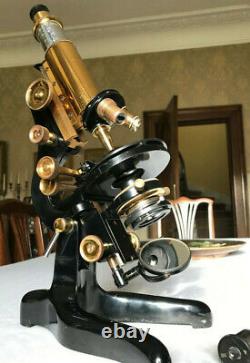
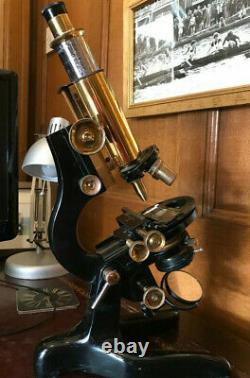
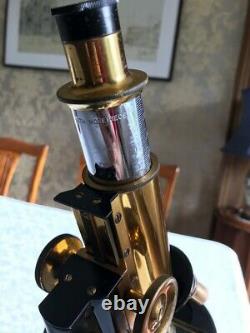
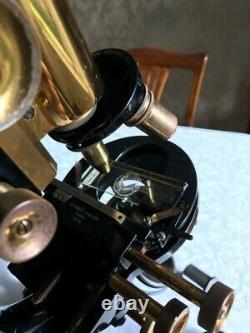
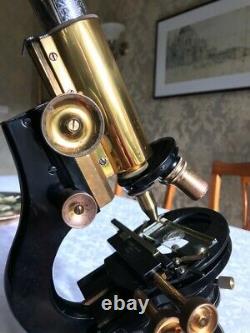
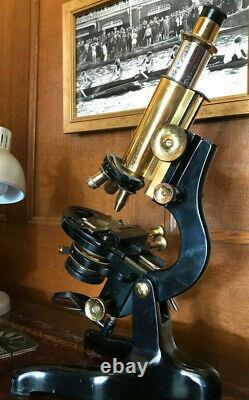
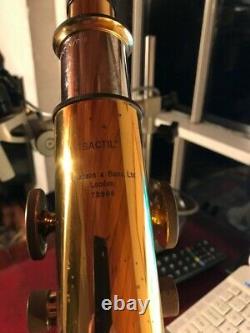
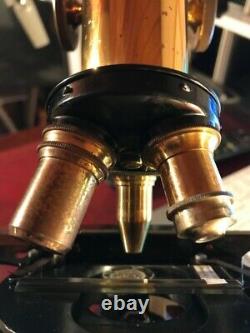
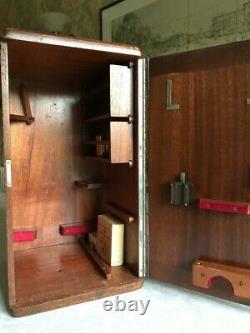
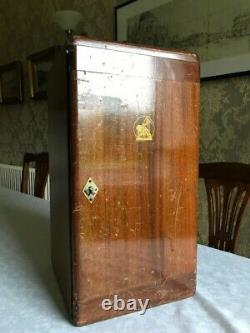
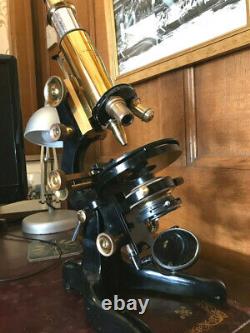
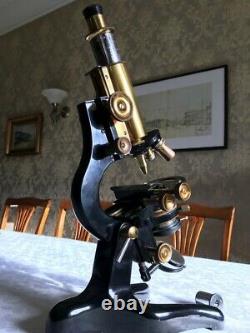

This listing is for a really well presented vintage original Bactil model microscope by W. Watson & Sons Limited of London. It dates from 1942 based on the sequential Watson production number of 75699, which is engraved onto the main lacquered brass tube.
Most Bactil models of this period were produced with a black-painted main tube, so this brass example certainly catches the eye and makes a fine imposing technical display instrument as well. This wartime example is an interesting proposition for the Watson collector because instrument production would have been low during wartime, with some production focus shifting to military requirements, so this fine brass example from 1942 will be quite a rare find. It's in all-original condition and has obviously been pretty well looked after by its former custodians. This Bactil also benefits from a good set of lenses and an original semi-circular brass full mechanical stage.
It presents really well with some amazing gleaming brass-work and just the right amount of patination to tell the story of its usage over the years. This lacquered brass details including its main tube and thumb-wheels are essentially only showing a few signs of age-related tarnishing and spotting including mainly on the thumb-wheels which where you'd expect and this is very much in keeping with its period, only adding to the instrument's character. The brass-work really catches the light well and glints with a lovely warm yellow/golden hue. The Bactil is essentially an excellent British optical instrument built from quality materials, with solid construction, great design and skilled workmanship and in this period many hours of hand-finishing.
This is therefore a very sturdy, heavy and good quality microscope in original condition, fully working, with just the right signs of age for a brass example from the early 1940s. On the technical side both coarse and fine focus move nice and freely with little wear evident. Coarse focus is via rack and pinion, with fine focus via a vernier screw system that moves a small internal cam, giving minute adjustment of the main optical tube. The upper frame also tilts to allow inclined viewing, holding in position as it should.Turning to the optics, the instrument comes fitted with a period graduated chromed eyepiece draw-tube and some appropriate vintage Watson eyepieces that with good illumination produce excellent images. 10x magnification - Watson - 6x magnification - Watson (this one has a military marking for June 1943). 2 inch - Watson Parachromatic - 2.5x low power scanning lens. 32mm - R & J Beck - 5x low-power.
2/3rds inch - Watson Parachromatic - 10x. Unmarked brass conical objective - 15x (approx).
1/6th inch - R & J Beck in brass - 40x (the lenses are also supplied with various lens canisters). Overall, the range of magnification available as currently configured, ranges from 15x to about 400x without the need to use oil immersion techniques. The mechanical stage is an original Watson factory-fitted item in brass which was available for both Watson's Bactil and Patna models during this period, with twin thumb-wheels on the right hand side of the stage for x/y control. It has a slide retention system consisting of two armatures one of which is sprung along with a couple of small spring-steel clips for additional support. This system is excellent for retaining slides during inclined viewing, with freely running x/y controls also offering great control of specimen positioning.
The stage can be removed easily for cleaning by winding it forward with the y-axis adjuster and then just pulling it off the dovetails. Turning to the sub-stage, we have a Watson Abbe-style condenser on a height adjustable rack and pinion mount with centering. There's a working iris to control lighting levels and lighting is via a 2 inch plano-concave mirror which is in very good condition on its adjustable brass support arm and gimbal set-up with excellent silvering to both sides.
There's also a 35mm swing-out filter carrier for adding coloured, opaque or dark-field filters. All controls operate reasonably smoothly including coarse focus, fine-focus, eyepiece draw-tube, condenser and plano-concave mirror.The instrument has been lightly lubricated and rebuilt so all controls operate nice and smoothly with no obvious maintenance issues evident. This is a great visual and working example of Watson's classic Bactil model in the sought-after brass finish making it quite an interesting proposition for a collector.
It's in highly original condition with a comprehensive specification, good optics and it's essentially very collectable. Please note that there is now a Watson Bactil storage case with this example - now shown in final listing photo - the case has internal lens racks, carry handle and a working lock with key. Thanks for looking - please also check out my other listings if you get a chance. Watson & Sons Bactil Monocular Microscope in Brass c1942, Cased" is in sale since Tuesday, November 2, 2021. This item is in the category "Antiques\Science/Medicine\Scientific Instruments".The seller is "arcboutant" and is located in Glasgow. This item can be shipped to United Kingdom, Austria, Belgium, Bulgaria, Croatia, Cyprus, Czech republic, Denmark, Estonia, Finland, France, Germany, Greece, Hungary, Ireland, Italy, Latvia, Lithuania, Luxembourg, Malta, Netherlands, Poland, Portugal, Romania, Slovakia, Slovenia, Spain, Sweden, Australia, United States, Bahrain, Canada, Brazil, Japan, New Zealand, China, Israel, Hong Kong, Norway, Indonesia, Malaysia, Mexico, Singapore, South Korea, Switzerland, Taiwan, Thailand, Bangladesh, Bermuda, Bolivia, Barbados, Brunei darussalam, Cayman islands, Ecuador, Egypt, Guernsey, Gibraltar, Guadeloupe, French guiana, Iceland, Jersey, Jordan, Cambodia, Liechtenstein, Sri lanka, Macao, Monaco, Maldives, Martinique, Nicaragua, Oman, Pakistan, Peru, Paraguay, Reunion, Saudi arabia, South africa, United arab emirates, Ukraine, Chile, Bahamas, Colombia, Costa rica, Guatemala, Honduras, Jamaica, Kuwait, Panama, Philippines, Qatar, Trinidad and tobago, Uruguay, Viet nam, Russian federation.
- Period: 1901 to 1950
- Antique: Yes
- Material: Brass
- Type: Microscope

